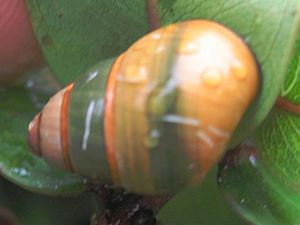Achatinella lila facts for kids
Quick facts for kids Achatinella lila |
|
|---|---|
 |
|
| Conservation status | |
| Scientific classification | |
| Kingdom: | |
| Phylum: | |
| Class: | |
| (unranked): |
clade Heterobranchia
clade Euthyneura clade Panpulmonata clade Eupulmonata clade Stylommatophora clade Orthurethra |
| Superfamily: |
Achatinelloidea
|
| Family: |
Achatinellidae
|
| Genus: | |
| Subgenus: |
Bulimella
|
| Species: |
A. lila
|
| Binomial name | |
| Achatinella lila Pilsbry, 1914
|
|
Achatinella lila is a special kind of land snail that breathes air. It's a mollusk found only in the northern Ko‘olau Mountains on the island of Oahu, Hawaii. This snail is part of the Achatinellidae family.
About the Snail's Shell
The shell of the Achatinella lila snail is very pretty. It is shiny and comes in bright yellow and green colors. The shell is shaped like a cone and is thin but strong.
It has about 5.5 spirals, called whorls. The very first whorls are often a burnt brown color. As the snail grows, these can turn whitish. The last part of the shell can be dark brown. Sometimes it has yellow patches or green bands. Each snail's shell pattern can be a little different.
The opening of the shell is called the aperture. It is usually white or a light purple inside. The edge of the opening is sharp. The shell is about 17 millimeters (0.67 inches) tall. It is about 11 millimeters (0.43 inches) wide.
Saving the Achatinella lila Snail
The Achatinella lila snail is a very important animal in Hawaii. It is also an endemic species, meaning it lives only in this one place. Sadly, these snails are in danger of disappearing forever. They are considered critically endangered.
These snails grow up very slowly. It takes them about five years to become adults. They also don't have many babies, usually only one to seven each year. Because of this, their populations can drop quickly.
Many things threaten these snails. New animals brought to Hawaii, like rats, eat them. Their homes are also changing or being destroyed. Sometimes, too many snails were collected in the past.
Scientists are working hard to protect them. In 1997, six snails were taken from the wild. These snails and their babies were raised in a safe place. This was the first time Hawaiian tree snails were brought back from captivity.
Now, groups of about 50 snails are being released back into the Ko'olau Mountains. Experts watch them closely using photos. They also look for shells of snails that have died. This helps them understand how the snails are doing.
In the future, they plan to keep watching the snails. They will also add more snails from the breeding program to help the population grow. These efforts are very important to make sure the Achatinella lila snail survives.
See also
 In Spanish: Achatinella lila para niños
In Spanish: Achatinella lila para niños


